How to Hand Spin Wool with a Viking Drop Spindle:
A Pagan’s guide to making the Stuff of the Universe
The Drop Spindle : Hand Spinning Yarn for Pagan Spells
How is yarn made from scratch?
2) Skirting Fleece
3) Washing Fleece
4) Carding for woolen and worsted yarns
Singing While Spinning : Icelandic Spinning Work Chant with mp3
This page is meant as an overview of how to spin yarn by hand, using a Viking style drop-spindle, wool combs and a diz, as was typical of that period.
Viking drop spindles were commonly made with a soapstone bottom whorls (the round stone) much like mine, though also ceramic, bone and more rarely, amber, metal or glass. They also used wool combs, some of which were found in Norway. Hand carders only came into use in the 12th century, they are not of the Viking period. I don’t use them and don’t see the need for them. Wooden blocks used to hold the combs are also of the viking period, and I use those too when teasing the wool through the diz. There’s no evidence of a diz being used… but then again, a diz is basically a button with holes, so they might not have been recognized as such (offsite reference and another one).
These are basically my notes on what I’ve learned. The net has much more in depth pages on each topic, and I give links to some of them. However, I haven’t found one that has all the topics together in one site, and none specifically intended for Pagans. Once you’ve read this, you’ll know what it is you want to learn more about, and you can look for it, because you’ll know the spinner’s lingo. Or maybe all you want is a general idea of how it’s done, in which case you’ll learn everything right here.
The Drop Spindle : Hand Spinning Yarn for Pagan Spells
I’m putting this information here for Pagans and Heathens who want to learn to spin wool for spiritual purposes. When I learned it, I was told it was useful for a hundred small magics, and I couldn’t imagine how that would be the case. Now I believe it. One example of this is described in my page on the Second Merseburg Charm for healing sprains and other injuries. The original in Old High German doesn’t mention using thread, as it has no instructions, but all the later Christianized ones do.
I’ve made instructions, rebuilt from the various sources, and learned much from trying it out on an actual injury. One of those is how important it is that you spin that black thread yourself if you want it to work. Thread that you’ve spun from natural fibers is almost alive, and more importantly, it’s part of you. If you know how to send energy down your arm, you’ll find sending down your handspun yarn feels exactly the same. And just like in your arm, you can stop it, squeeze it, store it there, or reverse the flow at will! The thread is an extension of you, which is immensely useful if you’re using it for a spell carried by someone else, such as for knot spells.
A traditional knot spell is one where you store a particular spell or energy inside a knot. To release the energy or activate the spell, simply untie it. You can either give the spelled yarn it to someone you trust, or save it for times when you’re unable to do magic, whatever the reason. Letting someone have this kind of yarn is equivalent to giving them your hair, with all the links that this implies. You could detach it completely from yourself I suppose, but that’s Advanced Topics.
Because the thread is intended for magical uses, you have to spin it with that intent. The easiest way to do that is with a work chant, and I’ve found one in Icelandic. Using a foreign language makes it harder to learn the chant, but then it makes it easier to forget what you’re singing about, and just focus on letting your hands flow with that rythm. The chant will carry the sacred intent for you. You can find it below, along with an mp3 to learn it.
Word Origin of “Stuff”
Here’s a fun word origin related to spinning, what is stuff?
The oldest word origin I could find refers to stuff as a plug made of coarse fibers, used to stop up a hole, such as in a ship. It also refers to a coarse wool cloth made of worsted yarn, and to the quilted cloth worn under chain mail. As a verb, it means either “to stop”, “to supply or cram full” , as in “to stuff a hole” or “to stuff a town with soldiers” (which is the earliest quote of that word).
So when you make worsted yarn, you’re making what stuff is made of. You’re participating in creating the Stuff of the universe!
How is yarn made from scratch?
1) Shearing The Sheep:
I’ll stick to woolen yarn to keep it simple (and it’s the only kind I know how to make). First, you’ll need a sheep. And a kilt. Sheep can hear zippers from a mile away. Never mind, bad joke. I’ve never had a sheep myself. Ahem. Then you shave the sheep. Again, I haven’t done this. Shaving sheep just isn’t one of my kinks. Nor have I watched a sheep being shorn. Not much of a voyeur, and the poor sheep ends up naked. What is WRONG with me today? Geeze! Mind OUT of the gutter, girl! Anyyyyway…
2) Skirting The Fleece: So then you have the fleece from the sheep. It’s full of crap. I mean that literally. There’s bits of grass, mud and other unmentionables in that fleece. But we’ll ignore those for now. Skirting means removing all the wool that is so short it is not useful for spinning. That means the short belly fleece, the matted and twisted little ends (tags), edges of the fleece, as well as bigger twigs and leaves. That short fur can be put aside for making felt, if you’re into that. I haven’t felt up to it yet. Even if you got your fleece already skirted, you’ll probably want to tease it out a bit, meaning you pull at the parts that are very tight, so that the water will be able to get in and clean it.
3) Washing the Fleece: The way I do it, I boil up water in a big pot, then pour it into a bucket. I add about half a cup of no-name liquid dishwashing detergent (many use Dawn dishwashing liquid). Not soap, soak is alkaline, soap is bad. Soap will turn your wool into felt. Detergent is good. I gently deposit the raw wool into the water, and use an empty 2 liter plastic bottle to push it down under the water. Then I gently use the bottle to stomp the wool so that the water gets in everywhere, dissolving the lanoline (grease) and getting out the dirt. Let it sit 15 minutes, empty the water, remove the wool. Put in equally hot water, put the wool on top and push it down gently, let it soak 15 minutes, drain the water. Repeat if the wool is still dirty or greasy until it isn’t. Then you squeeze some water out and let it air-dry on some sort of mesh surface or hung in a mesh bag. If it was really muddy, you could start with a cold water soak and rinse before using hot water and detergent.
This site explains it in more detail, this one uses a washing machine, They’ll give you more precise. This site is the one I used, and it says to rinse in progressively colder waters, whereas all the other ones only use the hottest water. I think using progresively colder waters was a mistake. My black wool had been stored for a while when I got it, and the lanolin hardened. So when I used hot water only once, and then colder waters, it hardened into dandruff like flakes all over my wool. Next time, I’ll wash it as many times as needed, but only in the hottest water. If it’s mud encrusted too, I’ll rinse it as many times as needed in just cold water (until the water isn’t brown anymore), before going to super hot water with detergent. Going from cold water to hot water is fine. It’s using hot and then cold water that creates flakes and felting.
This site is way too anal about preserving locks, but it’s funny. It assumes very clean fleece, unlike the Nasty Wasty Unholy Fleece From Hel I started with. Which is entirely appropriate, since I got that wool from Raven. Actually, the white wool I first got from him was sort of okay, just had very short fibers. It’s the black wool I got next that was… ugh! I had to soak it 9 times in cold waterto get all the mud out, it was short fibers, andit was all tangled. On the upside, if I can spin that crap, I can spin anything. It can’t possibly get any worse!
Crap. I said it, didn’t I? *sigh* I just had to go and say it… geeze. Still, it made a great yarn in the end. I MADE IT DO MY BIDDING!!!
4) Carding the Wool: Hand cards look like the brushes used on cats and dogs, just bigger. You use two of those, put some fleece in the middle, and pull apart, to get the fibers to line up. Do that until it looks all lined up, and put it in a pile. Carding video part 1 and part 2 in case you’re curious. (en francais, cardage de la laine)
I’ve never done this. Raven taught me how to card by hand, and it goes like this: take a lump of raw wool, pull out a pinch of it. What you’ve pulled out is mostly straight fibers. Pull out another pinch, lay it on top of the first one. Pull out another. Keep going. Eventually, you have a pile of fibers that are mostly lined up. Throw out any bits that are too short to line up as you go. That’s your carded wool, and you can use it to spin with your drop spindle.
However, if your wool is full of lots little bits of crap like his is, you first have to clean it by hand, meaning you take your lump, and remove every tiny twig you can find, stretching the wool as needed to get to it. This takes FOREVER. And it makes my back hurt, as I hunch over. He likes keeping his hands busy, so it’s not a problem for him. I have other things I’d rather do, so after doing research, I got myself some wool combs, and I completely skip the carding step. The combs are more effective at getting the crap out, and they get rid of the short fibers in a single step.
If you card the wool, you’re probably wanting to make rolag for the Long Draw Drafting Method, where you pull out thread from a fluffy mass and spin it directly. Here’s a video of a lady carding wool and making rolags. This will give you a woolen yarn. Here is a video of that same lady on how to use the long draw drafting method with a spinning wheel. The second video goes onto the rolag making, then back to spinning.
What is a woolen yarn? Keywords: Fluffy Warm Fuzzies!
IF you spin the carded wool directly, you’ll get a mix of short (1 to 4″) fibers and long fibers (4″ or more). This makes a woolen yarn.
Woolen yarns: have short fibers, a slack twist, are weaker, bulkier and softer. (en francais, fil cardé)
Woolen fabrics: Are soft, thick and fuzzy, warmer because a loose weave leaves more air inside to insulate, are less expensive and good for jackets and sweaters, and easier to remove stains from.
For Weaving on a Loom:: This kind of thread can be used for weft, meaning it’s the thread you pass back and forth between the stronger threads of the warp. It’s what you put in your shuttle, and it doesn’t need to be strong.
What is a worsted yarn? Keyword: Strong!
IF you card, then comb, or just comb the wool, you’ll only be spinning long fibers, and you’ll have a pile of discarded short fibers. This makes a worsted yarn, and the discards can be used to make felt. This is what I do. Though having recently started making felt, I’ve realized that you need lined up fibers, unless you’re fine with a lumpy uneven felt. Really, those super short fiber discards are only useful for stuffing.
Worsted yarns: have long fibers, a tight twist in spinning, are stronger, finer, smoother and harder. (en francais, fil peigné)
Worsted fabrics: are woven tighter, are flatter, smoother, harder, wrinkle less, last longer, hold a crease and shape.
For Weaving on a Loom: This is the thread you’d use for the warp on a loom. Warp are the long lengthwise threads through which the weft is woven. Warp holds the tapestry together. If the warp breaks, your whole thing falls apart. But you can use it for the weft too if you want.
v
From Wikimedia Commons, by PKM, and a picture of Leclerc shuttles sitting on the warp of a loom.
In 2006, I got a sudden irrisistible passion to learn to weave, which was out of character, because I’d never been into crafts before. I joined the local weaver’s guild, and wove one piece with a mentor’s guidance. Then I had some major surgery, and after I recovered, I found I no longer had any interest. Apparently, Someone decided I had to learn this. I can clearly visualize weaving now, and inspecting a tapestry for flaws. Maybe the Norns will have Work for me at some point, who knows?
If you want metaphor, warp is the thread of your life. Weft is the experiences you have that cross your life as well as that of others near you. The weaving is the passage of time and events that creates the tapestry of history.
5) Combing the wool: You don’t need to do this for woolen yarns. But I make worsted yarns, so I do this, and I skip the carding step. (en francais, peignage de la laine)
a) Lashing the wool / Loading or charging the comb: Take a lump of wool, and with a motion like you’re trying to whip the pointy ends of the comb, get it to catch on the tines (those things that look like nails). Repeat, until all that wool is stuck on the comb. Paradise Fibers has a great video on how to lash and comb wool. These are the combs I got from them.
b) Combing the wool: Use the other comb to grab the tips of the fibers from the first comb, until you have transferred as much fiber as you can to the second comb. Discard the short fibers from the first comb (they can be used for making felt or woolen yarn). Use the first comb to get all the wool off the second comb in the same way. Discard the short fibers. Do one more transfer if you feel like it. It’s easier to show it than to explain it.
If your discards are really short, they’re only good for felt, or for stuffing. If they’re not so bad, you can comb them to separate the short fibers from the absolute scrap that is only good for felt or stuffing.
Wool combs, with wool lashed onto the right one, sliver above
I got these combs from Paradise Fibers. I’m pretty happy with them!
6) Teasing the Wool: In order to spin wool, you need to pull some strands out in some kind of continous flow.
I was taught to draft the hand-carded wool directly onto the spindle. This method is only good with a drop spindle, because you have to manually adjust the thickness of your pulled fibers. That takes time if you want an even thickness of thread, and spinning wheels don’t stop. You can stop your drop spindle on your lap and take your time. That’s how I made my first yarn. Then I found ways to make this easier and the thread more even by using a diz to create wool sliver or wool roving .
To create a sliver: you take your bunch of carded or combed wool, hold it in place, and draw (pull) it out into a long strip where the fibers are parallel. If you and give it a slight twist, it becomes roving. Generally, you wind this up into a loose ball until you’re ready to spin it.
How do I hold my wool combs in place while I draw out the sliver or roving? Well, you can hold the comb down on the ground wiith your feet, which is what’s done in a number of low-tech cultures around the world. Or, you can have some sort of clamp to hold it in place on a table.
Here’s an offsite example of a wool comb clamp, and here’s a simpler wool comb pad from Paradise Fibers. I made a clamp with the help of my father with plywood, carpenter’s glue, and some long bolts and screws. I’ll put up some pics of that with the next picture update of this page.
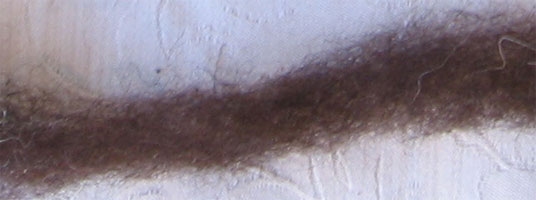
This is part of a sliver of wool, passed through a diz. See it bigger.
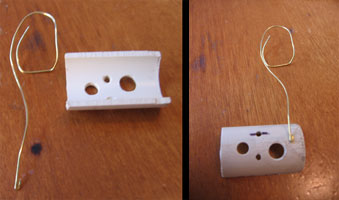
This is a diz made out of a 3/4″ pvc tube cut in half and drilled with 4 hole sizes. A brass wire is used to hook the wool and pull it through the hole
What is a diz?
a diz is generally a concave disc with varying hole sizes.
How do I use a diz ?
You pull the fibers that are on the comb though one of the holes with a thin hook, and then start pulling the fibers out the other side. This creates a more even and usually thinner sliver. You then even it out by hand, thinning out any thicker parts by pulling them apart.
video of how to use a diz, and another diz usage video.
Do I have to use a diz and a comb clamp?
No, you don’t. You can hold your comb with your feet and just pull it with your hands. The diz just helps make the roving more even.
7) Spinning Wool with a bottom whorl drop-spindle: This is almost impossible to describe with text!!! You really have to see it. (en francais, filage de la laine)
First, you need some leader yarn. String will do in a pinch. You tie your leader just above the spindle disc, and run it up to loop it around the top hook a few times. This is what your first bit of yarn will get attached to. Unwind the loose end of the yarn so the fibers are all loose. Draft a bit of wool out of your lump, or take the end of your sliver in hand. Join them together, back up with your fingers to give it about an inch (3cm) free, then spin your spindle so that inch gets all twisted. Pinch where your right fingers are with your left hand. Draft another inch of fibers out of your right hand, and let go with the left. Notice how the twist of spreads to the newly released fibers. Keep going.
I use a bottom whorl, meaning the soapstone disk is near the bottom. This is what viking drop spindles looked like.
Video1 top whorl , Video2 top whorl , Video3 spinning short fiber cotton with a bottom whorl, spinning wool with bottom whorl (good explanations, but too dark), Bottom whorl 2 (better) Bottom whorl 3 and part 2 of it, Bottom whorl4 by joyofhandspinning.

My Viking style soapstone drop-spindle, bottom whorl, loaded with spun wool (en francais, fuseau)
But I see spinners just pulling off a fluffy mass of wool fibers to spin thread on the spinning wheel, how does that work?
Ha, you caught me. Well, there’s more than one way to skin a cat. I’m making strong worsted yarn, so I comb, make roving or sliver, pull it out from the combs though a diz, and make a rolled up nest of roving. Then I use that to spin on the drop spindle, I either leave the rolled up nest on the couch beside me, or I hand it on my distaff to spool it down to the spindle.
The other way to do it, if you want a soft, fluffy yarn, is to just card the wool, which makes a fluffy mass, roll it between your cards to create rolag, then tease out a thin amount to spin on the wheel or drop spindle. I don’t have cards, so I’ve never tried this. This is called the Long Draw Drafting Method.
Here’s an old 1938 video of a woman carding wool, making rolags and then spinning on a spinning wheel.
Um, What’s a Distaff? Frigga has a Distaff in mythology, but what does that look like? How do I use a Distaff?
A distaff is a stick, which is either held under the arm, or stuck in the belt. It can be as short as two feet, or as long as 5 to 6 feet. The top of it is forked, or has a basket, or some way for the fiber to stay up there without sliding down. The reason you’d want to use a distaff is that you can walk while you spin. It takes tons of thread to weave, and tons of time to make enough thread to weave. So women would basically spin thread whenever their hands weren’t busy with something else, including while walking over to chat with Mrs. Jones down the road.
So when Frigga goes over to have tea with Freya, she’s probably got her distaff stuck in her belt, and spins with her drop spindle while they chat, no matter whether they’re sitting or taking a walk in the gardens. Yes, spinning wheels are faster, but they’re not portable. Drop spindles can be used practically anywhere, and are easy to carry.
My own distaff is a 5 foot rune enscribed linden walking staff. About a foot from the top, I’ve tightly spindled a bunch of black wool, so I have wool available for magical uses whenever I have it with me. I wrap roving loosely around the top of the distaff, or just poke the stick through a roving nest, and unspool from there. The wool yarn I have wrapped below it prevents it from sliding down. So I just unspool the roving and spin. I can walk and spin, with the distaff stuck tightly in my belt. I should add pics of that at some point.
8) Plying Yarn Singles: What you have on your spindle now is what’s called a single. Singles want to unwind, they’re not stable. They can be used to weave on a loom, provided you keep them under tension at all times. Otherwise, they’ll just fall apart. So what you do to make a stable yarn is ply it. Basically, imagine taking the entire length of what you’ve spun, and then folding it over on itself. Because they’re tightly spun, they’ll try to unwind if you give them slack. But, because you’ve folded them over, they’re trying to unwind in opposite directions. If you let them meet, they’ll start wrapping around each other. In fact, the more they try to unwind, the tighter they’ll wind against each other. This is how you ply them, and it creates a balanced yarn that won’t unwind. I just tie the middle end to a double loop on my shower curtain, and back up. At the far end, I tie it to my drop spindle, and spin it in the direction it wants to spin, which is the opposite of how I spun my thread in the first place.
Once that’s done, you loop it around on the back of a chair, tie it in a few places so it stays in place, and put the whole thing in a dish filled with water you’ve just boiled for 5 minutes. That sets the twist. Then you hang it to dry from a doorknob, with a weight at the bottom to pull it into being straight. Wait to dry, and that’s it.
Many find it simpler to have two separate single threads, and ply those. Yeah, but then you have to figure out which spin is which, and which way to spin the ply. If you fold it over, it limits how long a yarn you can make, but the direction is completely obvious. I’ve put some other details on plying in the Merseburg Charm page.
Are yarn singles useful for anything?
Yes. They can be used on a loom for making finer cloths, as they have thinner threads. But they’re harder to work with, because they have to be kept under constant tension to avoid unwinding and breaking. Some people even knit with it. Here’s a page on how to knit with wool singles and spinning low-twist singles yarn.
Singing While Spinning
Here is an Icelandic work song verse for spinning wool. I sing it when I spin, to get into the right rythm and a light trance. The thread comes out smoother when I sing than when I don’t; there’s a reason women used to use these work songs for traditional crafts, and Frigga advised that I always chant when I spin. I also sing it with all the other steps of making yarn, to put my spiritual intent into it. It’s a simple chant, but the end line of “Darkness is the reason” is intriguing. On the one hand, it could mean that you do this work in the evening. Or if you’re thinking in terms of the Norns, the three Fates, then it might be that the darkness in the world is what is forcing them to do their work. I think it adds mystery to the spinning verse.
When I get into a good rythm of spinning with it, I can get into a pretty euphoric trance state. Then I notice it, start talking in my head, and it’s gone. Doh!
Icelandic Spinning Chant mp3
| Kemba, spinna, tæja, tvinna
trogið þæfa í. Mala, skakam mín er vinna, mykrið veldur því. |
Comb, spin, tease, twine
stamp wool in a trough. Mill, churn, that’s my work Darkness is the reason |
Icelandic-Canadian Popular Verse, #182, p354 by Magnús Einarsson. Versifier unknown, recorded from Kamilla Anderson.
You can use the mp3 above to hear it, or use this slower version of the chant to learn it. I don’t always sing it this fast in practice. Sometimes I sing one word at a time, when I’m trying to comb through a tangle. It varies, and the tune varies too.
A reader of this page sent me a comment on the poem on November 13, 2011:
“I also thought I might be able to shed some light on the “darkness” in the Icelandic spinning chant you’ve posted on your page. I just hope it doesn’t rob you of the intrigue and mystery.
My intitial thoughts were: it’s not because it’s evening but rather because woolwork was the main activity during the winter when days get short in Iceland.
Then I came across more information about the chant and its creator:
It is a rhyme by Jens Kristjan Nikulasson Buch, who was born on Tjornes peninsula in Northeast Iceland on november 29, 1794 and died on July 19, 1873 at Reykir in Reykjahverfi, Northeast Iceland.
He made this poem at an old age, and apparently he was blind for several years before he died.
-Ari Pállson, Iceland “
My answer: “Excellent, thank you so much! No, it doesn’t rob the mystery. A poem means what it means to the listener. The creator’s intent is interesting but secondary, like with any art piece, it comes alive in the mind and heart of the viewer. So you’re not deleting my meanings, just adding to them.”
If you want to repost this mp3 on your site
The Nornic Rap
When I started writing this page, I was thinking of the Norns, and in a silly mood. So I wrote this Nornic Rap, just for fun. I hope they have a sense of humor…
Note that If you want to work in any way with the Norns, you have to learn some fiber art, be it knitting, crochet, embroidery, weaving or spinning. Spinning and weaving are probably best though. If you can’t work fibers, They’ll have no use for you, and therefore no time for you and your petty concerns. They’re very very busy. I’m told they also appreciate house cleaning as an offering, if you just need a little of Their time.
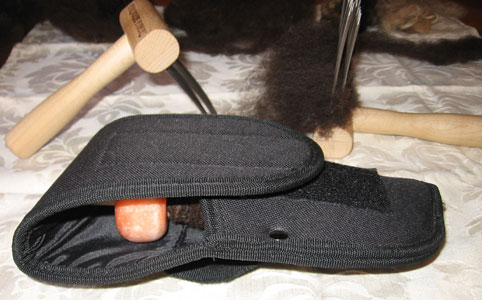
This is what I store my drop spindle in. Yeah. It’s a gun sheath. You gotta problem with that??? 😉
I can wear it on my belt, and do a quickdraw, spinning yarn at a moment’s notice. It fits real nice too.
Anyone messes with me, I’ll drop’em, spin ’em, tease and twine ’em.
Yeah, I’m a bad mudda Holda with an attitude!
And with that gangsta theme properly introduced, I give you…
The Nornic Rap
By Linda Demissy
Yo, this show, for the the Norns to know
Your destiny, is a thread they see
They’ll cut it short, if you don’t support
Their tapestry, you must agree
Gee, it’s ain’t free, *snap, snap, snap*
They’re doin’ their best, with your sorry mess
You call a life, they call it strife
They real busy, weavin’ their stuff
What makes you dizzy, to them is fluff
Stuff, ain’t enough, *snap, snap, snap*
So don’t cha go wastin’, their precious time
Lest ya learn ta spin, or you’ll clean their grime
You ain’t no good, ain’t part o’ their hood
Till ya spin and sing, it’s a nornic thing
*snap, snap, snap* spin and sing
*snap, snap, snap* it’s a nornic thing
*snap, snap, snap* Spin. And. Sing.

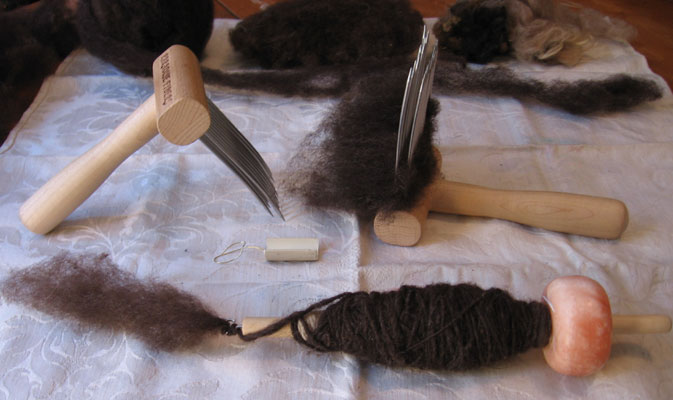
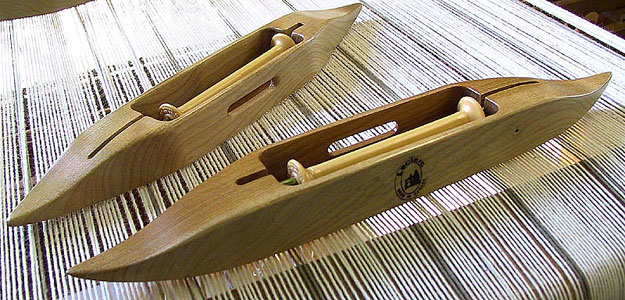


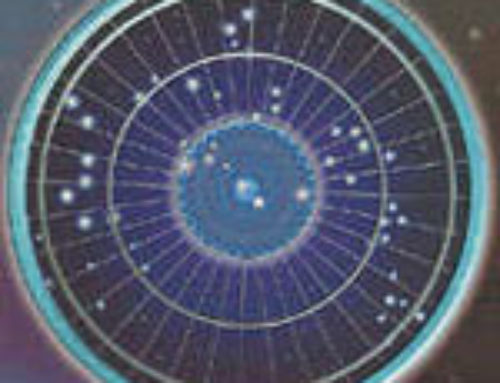
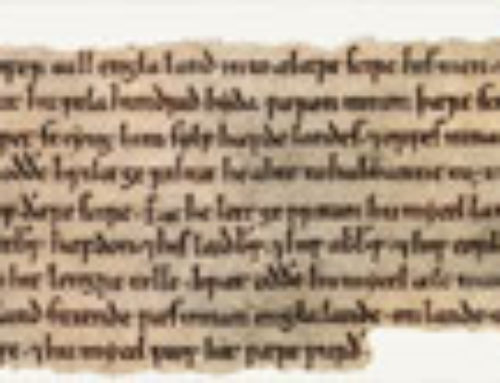
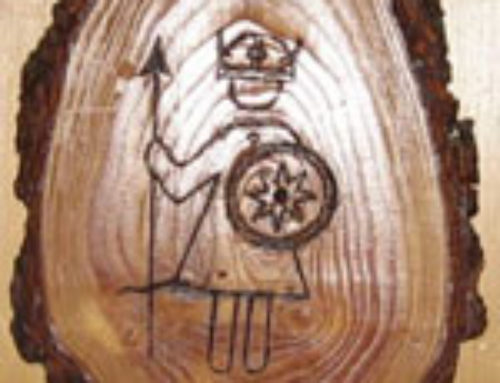
Leave A Comment
You must be logged in to post a comment.